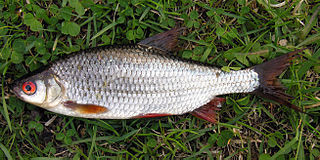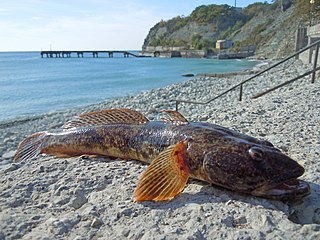
The roach, also known as the common roach, is a fresh- and brackish-water fish of the family Cyprinidae, native to most of Europe and western Asia. Fishes called roach can be any species of the genera Rutilus and Hesperoleucus, depending on locality. The plural of the term is also roach.

The Danube bleak or Caspian shemaya is a species of freshwater fish in the family Cyprinidae. It is found in Iran, Austria, Bosnia and Herzegovina, Bulgaria, Croatia, France, Germany, Hungary, Italy, Romania, Russia, Serbia, Slovenia, Turkmenistan, and Uzbekistan.

Knipowitschia caucasica, the Caucasian dwarf goby, is a species of goby native to marine, fresh and brackish waters along the coasts of the Black Sea, the Sea of Azov, the Caspian Sea and the Aegean Sea and to the Haliacmon drainage of Greece. It inhabits shallow waters with plentiful weed growth where it can find its prey consisting of small crustaceans, the larvae of chironomids and the larvae of the mussel Dreissena polymorpha. Spawning takes place after their first winter with the eggs being deposited onto the roof of a cavity formed by rocks, shells or plant materials. The male will remain to defend the eggs. This species can reach a length of 5 centimetres (2.0 in) TL

Mesogobius batrachocephalus, the knout goby or toad goby, is one of the species of gobiid fish native to the Black Sea and the Sea of Azov basins. It lives in estuaries and brackish water lagoons, occasionally in fresh waters, such as the coastal Lake Siutghiol in Romania. It prefers areas near cliffs with sandy, shelly or rocky substrates at depths of from 20 to 60 metres, sometimes down to 100 metres (330 ft). The knout goby is a piscivore. It can reach a length of 34.5 centimetres (13.6 in) SL and weight of 600 grams (1.3 lb). Maximum known age is eight years.

The Syrman goby is a species of goby native to marine, brackish and probably fresh waters of the Black Sea, the Sea of Azov and the Caspian Sea basins. They inhabit inshore waters with substrates composed of shell fragments, sand, mud or muddy sand. This species can reach a length of 24.5 centimetres (9.6 in) TL.
Barbodes katolo is an extinct species of cyprinid fish endemic to Lake Lanao in Mindanao, the Philippines. Males of this species reached a length of 11 centimetres (4.3 in) SL while females only reached 9.5 centimetres (3.7 in).

The stellate tadpole-goby is a species of gobiid fish native to the basin of the Sea of Azov where it occurs in the Gulf of Taganrog and limans of the eastern coast. It also lives in the lower Don River up to the Tsimlyansk Reservoir. It occurs in fresh and brackish waters of depths greater than 3 metres (9.8 ft), preferring shallow coastal lagoons and lowland rivers. Males can reach a length of 13.5 centimetres (5.3 in) TL while females only reach 11 centimetres (4.3 in) TL.

The eastern tubenose goby is a species of gobiid fish native to fresh and brackish waters of the basins of the Sea of Azov and the Caspian Sea and has invaded the upper reaches of the Volga River from its native occurrence in the delta. This species prefers slow flowing rivers or still waters with plentiful rocks or vegetation. It can reach a length of 9 centimetres (3.5 in) SL. It is probably the same species as that recently treated as Proterorhinus semipellucidus.

Ponticola cyrius, the Kura goby, is a species of gobiid fish endemic to the Kura River in the southern Caucasus countries of Georgia, Turkey, Iran and Azerbaijan. It reaches a length of 13 centimetres (5.1 in) SL. It lives in the upper parts of the Kura River, Massuleh River and the Pasikhan River and in the Anzali Mordab (Iran). Downstream in Kura it is replaced by Ponticola gorlap.

Ponticola gorlap, or the Caspian bighead goby, is a species of goby, a benthic fish native to the Caspian Sea basin. It is widespread in lower parts of many rivers in Iran, and also found in Azerbaijan and Turkmenistan. In Russia, it occurred in the lowest part of the Volga River up to Astrakhan until 1977, but has thereafter spread upstream. In 2000 it was recorded as being established in the Ivankovo and Rybinsk Reservoirs in the Moscow region, and already invaded the Don drainage by way of the Volga-Don Canal in 1972. This species occurs in sheltered environments, such as inshore fresh or brackish waters of estuaries, lagoons, lakes and large rivers, where it prefers habitats with a well vegetated rock or firmly packed sand substrate. It can reach a length of 20 centimetres (7.9 in) SL, and a common size is 12 centimetres (4.7 in) SL.
Turan's goby is a Ponto-Caspian species of goby endemic fish native to Turkey where it is only found in the Aksu Deresi stream. This species is found in a fresh water stream with a substrate of rounded pebbles. Males of this species can reach a length of 8.8 centimetres (3.5 in) SL while females only reach 8.3 centimetres (3.3 in) SL.
Neogobius pallasi, the Caspian sand goby or the Caspian monkey goby, is a species of fish native to fresh and brackish waters of the Caspian Sea basin including the Volga drainage up to the vicinity of Moscow. It has been introduced into the Aral basin. This species of goby can reach a length of 20 centimetres (7.9 in) SL. It is also important to local commercial fisheries.

Millerigobius macrocephalus is a species of goby native to coastal waters of the Adriatic Sea, the Levant Sea, the western Mediterranean and the Aegean Sea where it occurs in lagoons and shallow inshore waters to about 4 metres (13 ft) in depth with stones to provide shelter. This species can reach a length of 4.3 centimetres (1.7 in) SL. It is currently the only known member of its genus.

The granular pugolovka is a species of gobiid fish widespread in the Caspian Sea. It is a small fish, with a length up to 5.6 centimetres (2.2 in) TL. It was listed as Least Concern by the IUCN in 2008: there are no known major threats. Granular pugolovkas are very abundant in their habitat due to their size and lack of natural predators. The common name 'pugolovka' is a Ukrainian word for tadpole.
Caspiosoma caspium is a species of Ponto-Caspian goby native to the deltas of rivers inflows to the north-western Black Sea: Dnieper up to Berislav, also in the Dnieper-Bug Estuary and Berezan Estuary, Danube, Dniester with the estuary, Cuciurgan Reservoir. Found in the delta of the Don River, Volga, central and northern parts of the Caspian Sea and rivers flowing into the Sea of Azov. It can be found at depths of from 2 to 8 metres. This species can reach a length of 4.5 centimetres (1.8 in) TL. It is currently the only known member of its genus.

The Caspian stellate tadpole-goby, also known as the starry goby, is a species of gobiid fish endemic to the Caspian Sea basin. It is widespread along all coasts of the Caspian Sea with exception of the central-eastern, and in the lowest part of the Volga River. In the southern part of the basin, it is mentioned near the Ogurja Ada, in the Gorgansky Bay, and in the Sefīd-Rūd River. This species can reach a length of 10 centimetres (3.9 in) SL.
Knipowitschia cameliae, the Danube delta dwarf goby, is a species of goby known only from the brackish and fresh waters of a lagoon south of the Danube Delta in Romania. This fish is a shallow water species being found in waters less than 1 metre (3.3 ft) deep. This species can reach a length of 3.2 centimetres (1.3 in) SL. This species has been assessed by the IUCN as Critically Endangered, possibly extinct, it was last recorded in 1994 and surveys in that year and 1998 have failed to record the species. The specific name honours Camelia Iliana Nalbant, the wife of the senior author.
The black snake mackerel is a species of snake mackerel found worldwide in both tropical and temperate waters where they are found at depths of from 914 to 1,646 metres making diel vertical migrations from mesopelagic depths to the surface at night. It can reach a length of 25 centimetres (9.8 in) SL though most do not exceed 15 centimetres (5.9 in) SL. It is important to local peoples as a food fish. This species is currently the only known member of its genus, Nealotus. That genus is therefore said to be monotypic.

Nesiarchus nasutus, the Black gemfish, is a species of snake mackerel found in tropical and subtropical waters in most parts of the world, though not in east Pacific and north Indian waters. It occurs at depths of from 200 to 1,200 metres though they make diel vertical migrations from benthopelagic to mesopelagic depths at night. This species can reach a length of 130 centimetres (51 in) SL though most do not exceed 80 centimetres (31 in) SL. It is of minor importance to local commercial fisheries. This species is currently the only known member of its genus, Nesiarchus. That genus is thus considered monotypic.
Hyrcanogobius bergi, the Volga dwarf goby, is a species of goby endemic to the Caspian Sea where it occurs in fresh, brackish and marine waters along the coast. Unusually for gobies, this species is almost a pelagic fish. This species grows to a length of 3.6 centimetres (1.4 in) SL. This species is the only known member of its genus. The specific name honours the Soviet zoologist Lev Berg (1876-1950) who described many new species of goby from the Caspian Sea.














